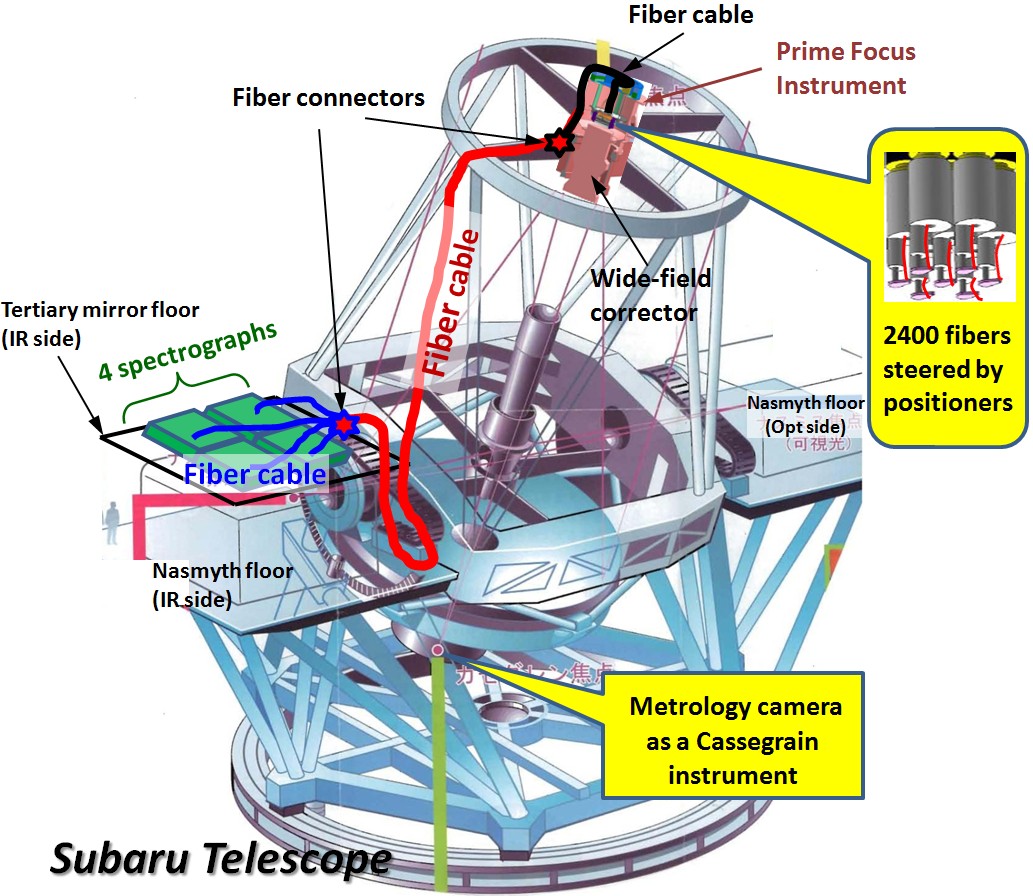 PFS is a fiber fed spectrograph system with a fiber positioner system designed to be mounted at the prime focus of the Subaru 8.2m telescope on Mauna Kea, and feeding 4 fixed spectrographs mounted near the Nasmyth focus. With 2400 fibers & fiber positioners, PFS allows simultaneous spectral observations of up to 2400 astronomical targets. Allocation for the PFS components on the Subaru telescope is shown left. This optical/near-infrared multi-fiber spectrograph targets cosmology with galaxy surveys, Galactic archaeology, and studies of galaxy/AGN evolution.
Taking advantage of Subaru’s wide field of view, which is further extended with the recently completed Wide Field Corrector (WFC), PFS will enable us to carry out multi-fiber spectroscopy of 2400 targets within 1.3 degree diameter. A microlens is attached at each fiber entrance for F-ratio transformation into a fainter (on slower) one so that difficulties of spectrograph design are eased. Fibers are accurately placed onto target positions by positioners, each of which consists of two stages of piezo-electric rotary motors, through iterations by using back-illuminated fiber position measurements with a wide-field metrology camera. Fibers then carry light to a set of four identical fast-Schmidt spectrographs with three color arms each: the wavelength ranges from 0.38 um to 1.3 um will be simultaneously observed with an average resolving power of 3000. Before and during the era of extremely large telescopes, PFS will provide the unique capability of obtaining spectra of 2400 cosmological/astrophysical targets simultaneously with an 8-10 meter class telescope.
PFS is a fiber fed spectrograph system with a fiber positioner system designed to be mounted at the prime focus of the Subaru 8.2m telescope on Mauna Kea, and feeding 4 fixed spectrographs mounted near the Nasmyth focus. With 2400 fibers & fiber positioners, PFS allows simultaneous spectral observations of up to 2400 astronomical targets. Allocation for the PFS components on the Subaru telescope is shown left. This optical/near-infrared multi-fiber spectrograph targets cosmology with galaxy surveys, Galactic archaeology, and studies of galaxy/AGN evolution.
Taking advantage of Subaru’s wide field of view, which is further extended with the recently completed Wide Field Corrector (WFC), PFS will enable us to carry out multi-fiber spectroscopy of 2400 targets within 1.3 degree diameter. A microlens is attached at each fiber entrance for F-ratio transformation into a fainter (on slower) one so that difficulties of spectrograph design are eased. Fibers are accurately placed onto target positions by positioners, each of which consists of two stages of piezo-electric rotary motors, through iterations by using back-illuminated fiber position measurements with a wide-field metrology camera. Fibers then carry light to a set of four identical fast-Schmidt spectrographs with three color arms each: the wavelength ranges from 0.38 um to 1.3 um will be simultaneously observed with an average resolving power of 3000. Before and during the era of extremely large telescopes, PFS will provide the unique capability of obtaining spectra of 2400 cosmological/astrophysical targets simultaneously with an 8-10 meter class telescope.
The PFS collaboration, led by IPMU, consists of ASIAA in Taiwan, USP/LNA in Brazil, Caltech/JPL, Princeton & JHU in USA, LAM in France, NAOJ/Subaru, IPMU in Japan. ASIAA will be in charge of the metrology camera system and also part of the Prime Focus Instrument components. The metrology camera system aims to take an image of the prime focus fiber array and measure their tip positions for fine tuning of fiber positions by commanding the fiber positioners, for the final purpose of achieving alignment between the science fibers and the selected celestial targets. The metrology camera system will be located near the Cassegrain focus taking image of the fiber array at the prime focus through the WFC, which is otherwise designed for the telescope imaging on the prime focus. To facilitate the metrology imaging, the 2400 science fibers will be back-side illuminated by illuminators in the spectrograph benches. The baseline design for the metrology camera is a large format imaging sensor to cover the whole fibers with a high-resolution single shot. Since the image distortion for mapping of the metrology camera result to the prime focus objects will be caused dominantly by the WFC, and the turbulence inside the dome of the telescope will also degrade the obtained image, certain numbers of back-lit fiducial fibers with precisely fixed positions on the focal plane (possibly in combination with the home reference positions of the science fibers) will be used for image calibration. The design of the metrology system includes both hardware (camera optics, imaging sensor, alignment mechanism, electric control module, thermal control module, installation mechanism, etc) and software (image acquisition and fiber position analyses).
Given that the overall fiber positioning accuracy requirement is 0.1", which is 9 um at the prime focus plane, and there exist several items to share the error budget, the preliminary requirement for the metrology camera is to measure the fiber positions within an error of 5 um. Moreover, since the time cost for the fibers completely reconfigured to the new field is aimed at about 40 seconds and about 8 iterations of Cobra movement are necessary, the measurement time requirement for the metrology camera is set to be less than 5 seconds (including exposure, readout, pixel calibration, centroid computation, compute distortion map). With all the requirements for the metrology camera, the current design is to have optics with the magnification factor of 0.0415 and the telecentric angle of 0.0017 degree, and to procure a large format 120M (12.7k x 9.5k) 2.2 micron pixel CMOS sensor (instead of CCD sensor which suffers from longer readout time).
The metrology camera will be built in ASIAA and then sent to JPL for the integration and test with the Prime Focus Instrument system. After the integration in JPL, it will be sent to Hawaii for the final system integration. Necessary testing setups will be also built inside the summit facilities of Subaru telescope for the final testing before real commissioning.


